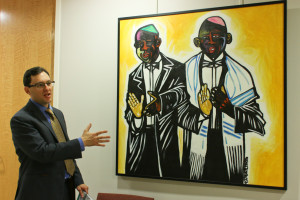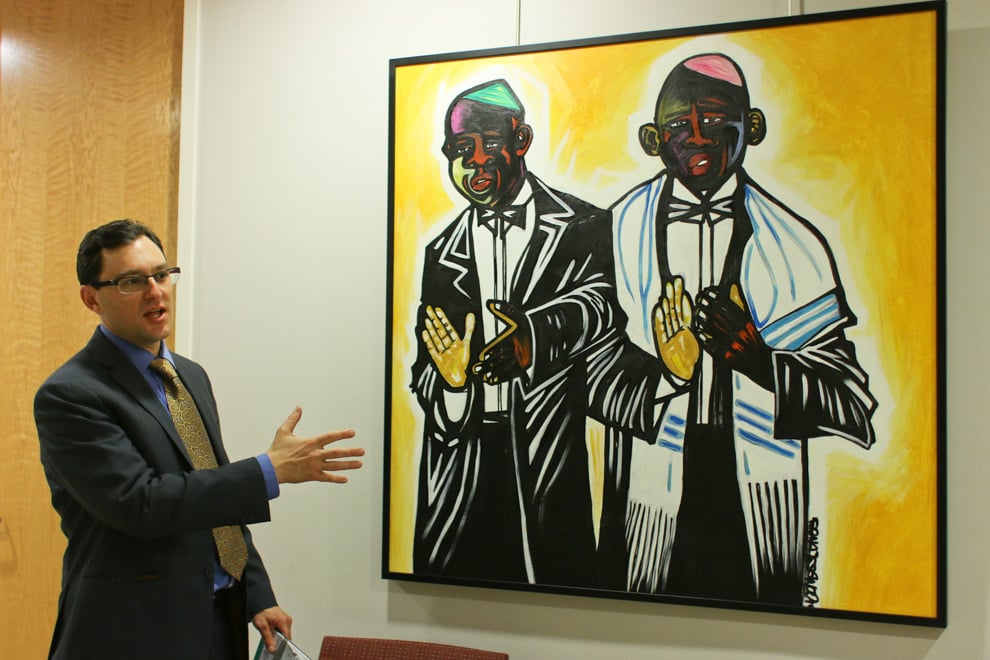
On Wednesday evening, Hillel hosted photographer Bryan Schwartz to speak at the gallery opening of his show, titled “Jews of Color: A Renaissance,” which will remain on display at Hillel until June 30.
The gallery show consists of photographs taken by Schwartz, who also works as a lawyer in Oakland, of Jews all around the world, accompanied by paintings by the artist Samuel Renaissance. Schwartz first contacted Hillel about planning this particular exhibit more than seven months ago.
“This story was really compelling to me because it’s a story that isn’t told,” said Heather Paul, the director of Student Engagement at Hillel who also manages its art gallery. “It really will go a long way toward breaking down everyone’s stereotypes of what Jews looks like and where Jews live and how Jews celebrate Jewish holidays and have Jewish experiences.”
Schwartz has been working on the project since 1999, when he was studying abroad in Europe during law school.
“On the weekend I’d go and spend Shabbat, which is the Saturday Jewish day of rest, with different communities wherever I was,” Schwartz said. “If I was skiing in Switzerland I’d go to Zurich and spend Shabbat there… So then I was going to North Africa, and I was like, ‘well, where are the Jews in North Africa?’ So I got my Lonely Planet Guide and went to the index and looked up Jews, and it said there was this community on this island off the coast of Tunisia, which had 15 synagogues on it and had the oldest Torah in the world, and I was just blown away by this.”
His experience inspired him to travel the world and photograph little-known Jewish communities.
“I got this idea that since I love to travel and I’m a photographer that maybe there are places that I don’t know about, like this, all over the world, that I could find and visit and share with people and share… the multicultural nature of the Jewish world,” Schwartz said.
He particularly wanted to break down stereotypes people may have of what constitutes a Jewish identity.
“You might have a concept of what being Jewish is that has something to do with this particular experience here that we’re having as Jewish people in Silicon Valley, at Stanford University,” Schwartz said. “Or maybe your experience of what Jewish people are has to do with New York — Jewish people are people who eat bagels and lox and love Seinfeld and go to Broadway shows. Or perhaps it’s the Israeli concept of Jewish.”
But Schwartz emphasized that these perceptions are not universal to the Jewish experience.
“These are all conceptions that… have absolutely nothing to do with being Jewish at all… They have to do with the places that we live,” Schwartz said. “There are Jewish people having life experiences and having conceptions of particular ideas — that their Jewish world is the way Jews are — in practically every part of the planet,” he added.
For the gallery show on display at Hillel, Schwartz partnered with a fellow Bay Area artist, the painter Sam Renaissance, who contributed paintings interpreting Schwartz’s photographs. The event attracted a mixture of students and community members interested in learning about Judaism around the world.
“I was really excited to see that Hillel and the Jewish community was incorporating ethnic identities into its programming that weren’t necessarily Eastern European or the conventional view of whiteness,” said Benny DeMayo ’18, who attended the gallery opening. “I feel like a lot of the Jewish community’s programming is very focused around that specific culture, and myself not being an Ashkenazi Jew, I was excited to see that there were other cultures represented.”
Schwartz’s photography project is 16 years in the making and has taken him to 30 countries on five different continents, where he has photographed Jewish communities in places like Ghana, India and Peru. Everywhere he went, he said, whether the Jewish community was thriving or dying, he was welcomed with open arms.
“It’s not so much the bagels and lox or the fufu or the ceviche that really characterizes us as a people,” Schwartz said, referring to traditional foods that he ate in Ghana and Mexico. “What it is… is the tent of Abraham, the idea of welcoming a stranger, which goes back to the very origin of the Jewish people and is really still part of the character of the Jewish people around the world … we’re all part of this extended family, and that is how I was treated wherever I went around the Jewish world.”
Contact Sarah Wishingrad at swishing ‘at’ stanford.edu
